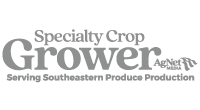Rick Dantzler, Citrus Research and Development Foundation (CRDF) chief operating officer, reported that the foundation’s January board of directors meeting was a productive one that resulted in the approval of several key citrus research projects. “We had a great meeting. The board approved funding to use a strain of Bacillus thuringiensis (Bt) to kill the progeny of psyllids,” Dantzler said. …
USDA Funds Citrus Projects
The U.S. Department of Agriculture (USDA) announced an investment of more than $70 million in the Plant Protection Act program. This includes funding of 357 projects in fiscal year 2025. The work will strengthen the country’s defenses against plant pests and diseases, safeguard the U.S. nursery system, and enhance pest detection and mitigation efforts. Part of the funding is going …
All In For Citrus Podcast, January 2025
Recently, the University of Florida Institute of Food and Agricultural Sciences (UF/IFAS) reported research on the development of a new type of citrus tree that can fight off the HLB-spreading Asian citrus psyllid (ACP). The genetically modified tree has only been tested in the lab and the greenhouse, but the research looks promising. The approach involves inserting a gene into …
Indian River State College Students Help Decode Asian Citrus Psyllid Genome
A groundbreaking research collaboration led, in part, by Indian River State College Professor Tom D’Elia, has resulted in the successful annotation of the Asian citrus psyllid genome. This marks a significant advancement in the fight against citrus greening disease. The research, published in GigaScience, represents an achievement in both scientific discovery and undergraduate education, featuring 28 Indian River State College …
CITRUS NURSERY SOURCE: Citrus Researchers Coming Together
By Peter Chaires Florida’s citrus industry is well supported by two phenomenal research institutions: University of Florida Institute of Food and Agricultural Sciences (UF/IFAS) and U.S. Department of Agriculture-Agricultural Research Service (USDA-ARS). UF/IFAS provides research and Extension support from its main campus in Gainesville, as well as from its research and education centers and county Extension offices across the state. …
Research Paves Way to Enhance Citrus Nutritional Value
Scientists have decoded the intricate metabolic profiles of citrus fruits, shedding light on the phenylpropanoid pathway. The pathway is a critical biosynthetic route for flavonoids and other phytonutrients known for their health benefits. By revealing the genetic mechanisms underlying these compounds, the research offers an approach to enhancing the nutritional value of citrus through innovative breeding and genetic improvement strategies. …
Medications and Grapefruit Could Be Compatible
In an advance that could change how millions of patients take their medications, researchers have identified the genetic mechanism behind grapefruit’s notorious interaction with prescription drugs. The discovery opens the door to developing new varieties of grapefruit that won’t interfere with medications, potentially allowing patients to safely enjoy the fruit again. For decades, healthcare providers have advised patients to avoid …
Study Shows Impact of HLB Bacterium on Roots
A recent study sheds light on the significant effects of Candidatus Liberibacter asiaticus (CLas), the bacterium responsible for HLB, on the root systems of grafted Valencia orange trees. The findings reveal that root system reductions caused by the infection are more extensive than the corresponding aboveground declines. That finding underscores the hidden yet critical impact of the disease below the …
Experimental Citrus Tree Kills Young Psyllids
Scientists at the University of Florida Institute of Food and Agricultural Sciences (UF/IFAS) are testing a new type of citrus tree that can fight off the HLB-spreading Asian citrus psyllid (ACP). The genetically modified tree has only been tested in the lab and the greenhouse but is very promising as a potential solution to HLB. The approach involves inserting a …
Research Center to Combat Brazilian Citrus Diseases
The Applied Research Center for Innovation and Sustainability in Citrus Farming was inaugurated Dec. 12 in a ceremony at the Palácio dos Bandeirantes, seat of Brazil’s São Paulo state government. Its purpose is to combat the main citrus diseases, such as citrus variegated chlorosis, sudden citrus death and above all, citrus greening. The São Paulo Research Foundation (FAPESP), Fundecitrus and …
Progress Being Made in HLB Fight
Texas A&M AgriLife Research scientists led by Kranthi Mandadi are seeking novel solutions to huanglongbing (HLB), also known as citrus greening disease. Mandadi is a professor in the Texas A&M Department of Plant Pathology and Microbiology and a researcher at the Texas A&M AgriLife Research and Extension Center at Weslaco. In the past few years, he and his collaborators have …
CRDF Board Approves Four More Projects
The Citrus Research and Development Foundation (CRDF) held its governance and plant improvement committee meetings along with its board of directors meeting on Dec. 3 in Sebring. Rick Dantzler, chief operating officer, said several orders of business were conducted as the year comes to a close. “The CRDF board of directors approved four projects at its last board meeting of …
Florida Researchers Visit Brazil’s Citrus Industry
University of Florida Institute of Food and Agricultural Sciences (UF/IFAS) citrus researcher Fernando Alferez recently visited Brazil’s Fundecitrus, as well as orchards and experiments in Brazil’s citrus region. Alferez, an associate professor of horticulture at the Southwest Florida Research and Education Center, was accompanied by researchers from Fundecitrus and Embrapa Cassava & Fruits. The project coordinator of Florida’s Citrus Research …
Australian Lime Interstocks to Combat HLB
By Ozgur Batuman, Sanju Kunwar and Ana Redondo In a promising effort to protect citrus from huanglongbing (HLB), University of Florida Institute of Food and Agricultural Sciences (UF/IFAS) researchers are exploring the potential of Australian lime as an interstock graft for Valencia scions with Swingle rootstock. The interstock technique uses various limes, known for their natural HLB-tolerant peptides, between the …
Rootstocks Show Drought Tolerance in Brazil
The drop in Brazil’s 2024 citrus harvest is due, among other factors, to the long period of drought observed in the Citrus Belt, according to Fundecitrus. Mitigating problems related to periods of drought is the objective of several studies being conducted by Fundecitrus, Embrapa Cassava and Fruits, Coopercitrus Credicitrus Foundation and the Agronomic Institute (IAC). One of these studies takes …
Hurricane Damages Georgia Citrus Research Plot
Jake Price with University of Georgia (UGA) Cooperative Extension recently described Hurricane Helene damage to the UGA citrus research plot. His observations, slightly edited, are as follows: When I had a chance to look at our citrus research plot, I expected the worst. But to my surprise, all of the trees were still standing. There was limb breakage due to …
Citrus-Derived Endophytes Have HLB Management Potential
Florida-based scientists published an article in Microorganisms indicating citrus-derived endophytes have potential for managing HLB. Endophytes are endosymbionts, often bacteria or fungi, which live within a plant for at least part of its life cycle without causing apparent disease. The authors of the article are Jessica Dominguez, Krishnaswamy Jayachandran and Kateel G. Shetty of Florida International University, and U.S. Department …
The Good, the Bad and the Ugly: Optimizing OTC Injections
By Ute Albrecht, Caroline Tardivo, Larissa Nunes, Gabriel Pugina, Gerardo Moreno and Jasmine de Freitas As growers are well into the second year of oxytetracycline (OTC) injections since approval for commercial use, more and more data are accumulating. The good news is that in all University of Florida Institute of Food and Agricultural Sciences (UF/IFAS) trials, trees have been responding …
CRDF Funds OTC and Other Research Projects
The Citrus Research and Development Foundation (CRDF) board of directors had a busy meeting in September. The board approved several research proposals for funding. And one researcher was asked to revise and resubmit a proposal. “A complicating factor was several of the proposals were put together before the ‘off-year’ of oxytetracycline (OTC) usage was repealed, but we concluded that it …
Frequent Irrigation Benefits HLB-Infected Sweet Orange Trees
By Tripti Vashisth and Mary Sutton Citrus trees affected by huanglongbing (HLB) show significant root dieback. This dieback results in smaller root systems than would be seen in healthy citrus trees. These small root systems are limited in their uptake capacity. In other words, if an HLB-affected tree is given the same amount of water as a healthy tree, the …





























